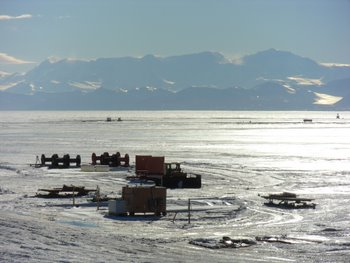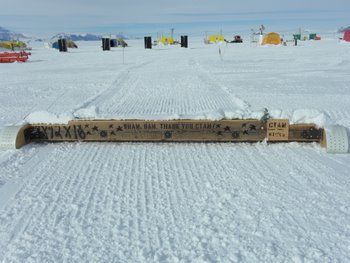There are four runway systems associated with the USAP(abbreviation) United States Antarctic Program that operate from late winter (WINFLY - usually sometime in late August) through the austral summer. Three of them are located within driving distance of McMurdo, while the fourth, is located at the Amundsen-Scott South Pole Station. When I flew in on December 6th, 2010, the C-17 landed on the annual Sea Ice Runway. To access the runway, vehicles drive over roughly three miles of sea ice road that extends from land and transitions on to the sea ice. It operates from October into sometime in December, depending on when the sea ice becomes too unstable, beginning to melt and break up. We were one of the last flights to land on the sea ice; one week after we arrived, over the course of two days, they had moved the airfield to the Pegasus White Ice Runway.

Pegasus White Ice Runway is about eighteen miles from McMurdo on the McMurdo Ice Shelf. Of all the American-operated runways, it is the most unique. It overlies about 110 feet of glaciated ice shelf and has roughly three-four inches of compacted snow on top (white ice). A third airfield, Williams (Willy) Field Skiway has not been used this year. It lies on the Ross Ice Shelf about seventeen miles from McMurdo. It sits on top of about 25 feet of compacted snow which lies on top of 260 feet of ice. All of this is gloating over approximately 1,800 feet of water. Willy Field can only host planes with skis; wheeled planes would sink into the snow.

The fourth American airfield is located at the South Pole. Planes generally only fly to and from the Pole from October to February. Its skiway is much longer (14,000 feet) than the runways/skiways at the other airfields; because of the altitude and thin atmosphere, it takes planes longer to stop. It lies atop 9,300 feet of accumulated snow and ice. The skiway is made of compacted snow and made level by towing implements. Grooming of this runway must be done daily to prevent drifting snow from making the skiway unusable. When weather permits, there are many flights daily; there's only a small window of time to transport all the winter's supplies to the station.
CTAM also possesses a skiway. Large deep field camps hosting many scientific expeditions require lots of support for transporting people, scientific cargo, camp supplies, and fuel. CTAM has regular LC-130 (Hercules) flights as well as helicopters and twin otter airplanes supporting and transporting scientific parties into their remote camps. Its skiway is maintained on a daily basis by camp personnel using a snow cat.

This trip had a lot of air travel firsts for me: first time on a C-17 and an LC-130 (different from C-130s in that they have skis instead of wheels). It was the first time I've landed on sea ice or a snow covered ice shelf. Hopefully, we'll be able to get our reconnaissance flight of the Shackleton GlacierA mass of ice that persists for many years and notably deforms and flows under the influence of gravity. in before we leave. That will be the first time I've flown in a twin otter and landed on a glacier. So, let's hope the weather clears soon and we can leave our camp here at Mt. Hope.


Comments